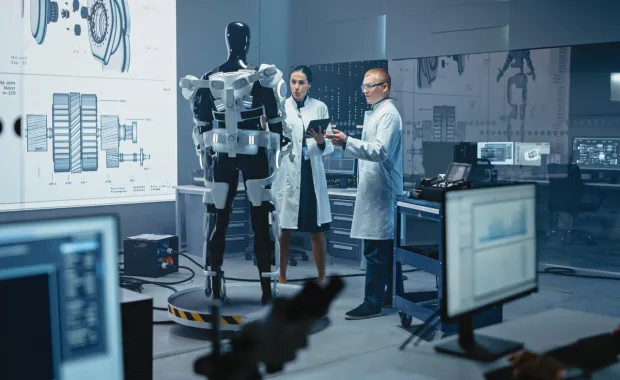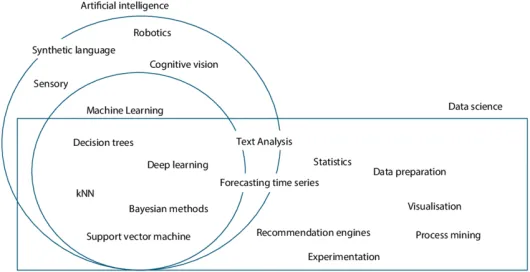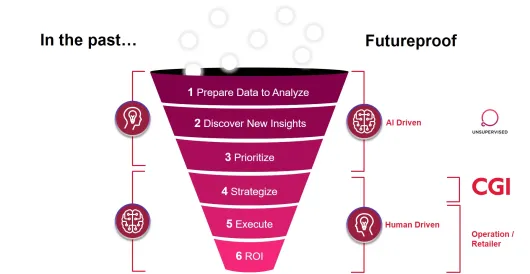It has probably not escaped your notice that a Digital Transformation (DT) is taking place. A true fourth industrial revolution, or in other words a major and fundamental change in our business processes and how we use technology worldwide. Emerging technologies are driving this revolution. These include cloud computing, big data, internet-of-things (IoT) and artificial intelligence (AI).
Of these technologies, AI is the most disruptive due to its new and unknown yet promising differences. AI applications are no longer just used in controlled, static environments such as data labs, but rather becoming part of the operational IT landscape. This entails that AI applications are supported and realized in the daily business processes. The development and application of AI-based components in such operational IT chains differs fundamentally in a number of ways from what we are used to. This article provides a brief overview of the AI field and then describes how to successfully apply AI applications within organizations and what additional requirements AI imposes on them.
Overview of the AI field
The fields AI, Machine Learning and Data Science are often used interchangeably, but how do they relate to each other? AI is the field of replicating human problem solving using computational techniques. Initially it was through logic and decision trees, then statistical methods which people refer to now as Machine Learning (ML). So you can think of ML as a subset of AI. Typical ML models contain feedback loops to learn and thus can continuously improve when provided with the correct quality and quantity of data. Then the models can adapt and optimize themselves. Both AI and ML overlap to a large extent with Data Science. The Data Science field combines domain knowledge, programming skills, and statistical knowledge to gain valuable insights from large amounts of data. The figure below (Figure 1) schematically shows how Data Science, ML and AI relate to each other.
AI has been around since the 1960s and until recently was mainly applied on a relatively small scale in a controlled, static environment. Nowadays, strongly decreasing costs for data storage, computing and network technology (delivered from the Cloud) enable enormous scaling. With this increased availability of (big) data in combination with advanced (near/real-time) data analysis solutions, the AI boost becomes a reality!
Applying AI successfully within organizations
The AI boost brings numerous opportunities for organizations, but how do you effectively apply the available AI applications within the operational IT chains? Probabilistic models may do more justice to reality (which comes with uncertainty), but this requires adjustments throughout the chain that depends on it. And this also requires adjustment of people as far as interpretation goes. By way of explanation: testing the same input will always return the same output. Successful application starts with determining the right use case. Then it is important to choose the right tools and approach. Finally, organizations must consider the exploitation of the intended output(s) in the IT business processes as well as laws and regulations in this area.
Step 1: Use-case
As mentioned above, the development and use of AI solutions is fundamentally different from what we are used to due to its probabilistic approach. This means that the output is potentially of great value, but also has a margin of uncertainty. The development of AI solutions is therefore often hypothesis driven and typically through multiple short cycles in close collaboration with end users.
AI solutions lend themselves well to use cases where this probabilistic, or predictive, output plays a key role. Well-known use-cases include: chatbots, self-driving cars, and advanced forecasting algorithms for, for example, maintenance and load of complex infrastructures. After identifying the problem, it is important to collect the right (amount of ) data as input source and determine the quality of the data. Then the building of models and/or prototypes can be considered.
Step 2: Tools
With programming languages such as Python and R you can create models that provide insights into workable solutions for the business case. This requires technical skills and time. However, there are also numerous directly applicable AI platforms available which are called “off the shelf” solutions. One example is the Unsupervised platform. Unsupervised is a platform that identifies patterns in data that regular BI tooling or common sense will not detect at this speed. The platform quickly reduces input data and arrives at reliable insights, so there is no limit to the amount of input data within this platform. After insights have been identified and translated into workable solutions, it is important to apply them in the operational IT environment.
Step 3: Implementation
The development of the AI solution can be done in many ways and depends on the tools chosen earlier. In this article, we provide an example of an "off the shelf" application that was used. CGI, in collaboration with Unsupervised, applied AI to data from a large retailer. In the process, surprising insights were uncovered. Figure (2) below shows the transformation in the implementation of AI driven solutions.
In the past (left), input data processing was a slow and error-prone process. The application of AI earlier in the data processing process (right) provides (mostly) automated output, allowing the data pre-processing model to be applied dynamically in a future-proof operational chain. This offers perspective, as it allows for the addition of more input data without losing speed in the analysis phase. Then, using targeted information, patterns, variables and expert knowledge, analyses can be applied to gain insight into where the targeted action leads to optimization. Think of time, money, or the process itself. The analyses in the future-proof chain provide more precise output due to the large amount of input data. Another possibility is to fully automate the decision chain, without human intervention. However, this poses a moral challenge: Who is responsible if things go wrong? And how do we deal with ethical considerations?
Step 4: Legislation and regulation
As mentioned earlier, the large-scale application of AI is still relatively new and unknown. As a result, legislation and regulations sometimes lag behind. Think for example of the AVG law or the ePrivacy regulation. How much data may an organization collect and process within the framework of these laws? Various judicial and social studies are often already further along and are investigating issues such as, for example, the case of a self-driving car. How should the self-driving car react when it can no longer brake in time and will cause a collision? The algorithm of the self-driving car has the choice between colliding with a motorcyclist or a full family car. Who is responsible in this situation? The algorithm or its creators or the person in the car? In such cases, making ethical considerations is of great importance.
By focusing on the corporate values of (digital) ethics, creating strong data governance and transparency in data coding and analysis (by reducing human bias), AI, ML and Data Science solutions can be more in line with future developments and even accelerate them. Slow(er) responses of law and regulations don’t need to slow down the digital transition.
AI solutions demands extras on operational business processes
AI predictions are increasingly transcending data labs and becoming part of operational business processes. The outcomes of data analytics include trends and patterns that can be of tremendous value in making business decisions. The outcomes often have a predictive nature that prepare the business for the future. Such outcomes are of great value even in high-impact chains where high levels of security, reliability and stability are of life and/or national importance (also called mission critical chains ). An example is the electricity network and the prediction of, for example, energy production and failure of network components.
The so-called non-functional requirements such as performance, availability, security, scalability, manageability, and extensibility then suddenly play a crucial role. The AI application can partly take care of these requirements, but the way of working and organizing around the solution are also important. These are the so-called three P's; Product, People & Processes, which we already knew before AI made its appearance. Think of the formation of BizDevOps teams in which business experts together with tech-savvy people take care of the further development and (24x7) management. These teams work together with the existing DevOps teams in their mostly scaled Agile organizational model. This model focuses on shaping and keeping IT processes in shape by making continuous adjustments to the IT landscape. No more separation between business, development, and management. Thinking and organizing in traditional applications and projects, makes way for thinking in chains of continuously changing IT components.
Wrap-up
Data Science and AI have been around for decades but have been experiencing a huge growth spurt in recent years. This is due to the development of deep learning and efficient neural networks. The solutions are increasingly becoming part of operational IT business processes. Also, in mission critical chains where high levels of security, reliability and stability are required.
The enormous computing power and speed of AI exceeds our human capabilities. The shift to AI requires a different way of development (hypothesis driven) and application. Legislation will also pick up on this as soon as sufficient leads are visible, but keep in mind that this usually lags behind technical developments.
In short, the development and application of AI in operational IT chains differs in some fundamental ways from what we are used to. However, it has been proven that the (potential) business value in the meantime is too great to ignore. AI is already providing important links for mission critical operational chains and this number is sure to grow in the coming years.
CGI is happy to help you create data-driven business solutions. By combining AI expertise with business knowledge, we create new insights and opportunities for our customers. Want to know more about AI solutions within CGI? Please contact Mirjam de Groot.
Read more?
- https://www.cgi.com/en/case-study/public-safety/cgi-and-national-crime-agency-partner-deliver-intelligent-automation-solution
- https://www.cgi.com/en/blog/5-common-pitfalls-ai-implementation-how-to-avoid-them
- https://www.cgi.com/en/blog/utilities/how-computer-vision-and-ai-can-revolutionize-supply-chain-and-grid-management-for-utilities
- https://www.cgi.com/en/article/manufacturing/webinar-uddeholm-working-with-artificial-intelligence-to-become-profitable-sustainable









